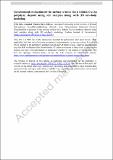Geochemical evaluation of the surface erosion for a hidden Cu-Au porphyry deposit using soil samples along with 3D ore-body modeling
Author(s)
Moradpouri, Farzad; Ahmadi, Seyed M. H.; Ghaedrahmati, Reza; Barani, Kianoush
Download12517_2022_10335_ReferencePDF.pdf (1.945Mb)
Publisher Policy
Publisher Policy
Article is made available in accordance with the publisher's policy and may be subject to US copyright law. Please refer to the publisher's site for terms of use.
Terms of use
Metadata
Show full item recordAbstract
Abstract
As the exploration process is time-consuming, costly, and risky, determination of the erosion surface of a metallic deposit before geophysical survey and exploration drilling might be very helpful. Therefore, one can use geochemical halos to determine if the surface erosion is a supra-ore or sub-ore and reduce the risk of exploration operations. The aim of this paper is to determine the erosion surface of the North ROK porphyry deposit (NRPD) in north-western British Columbia in Canada using linear productivity (LP) as the content of an element defining the halo multiplied by the width of the halo in meters. Thus, the 2045 soil samples from the B horizon were analyzed using ICP-MS for 36 elements such as Cu, Mo, Pb, Zn, Au, As, Ag, Ni, Co, Fe, Mn, and some other elements. First, the dataset were analyzed to obtain the statistical parameters, and the elements Cu, Mo, Pb, and Zn were chosen to calculate the linear productivity and the total linear productivity. Then, the aforementioned elements were modeled using the probability plot to identify and separate subpopulations in terms of anomalous halos and background including the threshold values of each subpopulation. The results of the probability plot modeling and thresholds values were then used to map the distribution of each element in GIS to calculate the linear productivity. The total linear productivity was calculated which indicates the erosion surface as supra-ore. Finally, the borehole data was used for a 3D ore-body modeling of the elements Cu, Mo, Pb, and Zn which validate and demonstrate the obtained results.
Date issued
2022-06-13Department
Statistics and Data Science Center (Massachusetts Institute of Technology)Publisher
Springer International Publishing
Citation
Arabian Journal of Geosciences. 2022 Jun 13;15(12):1164
Version: Author's final manuscript